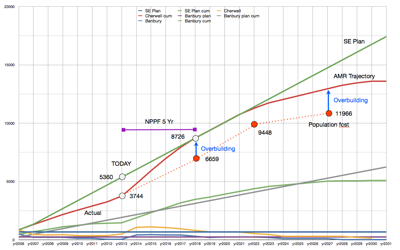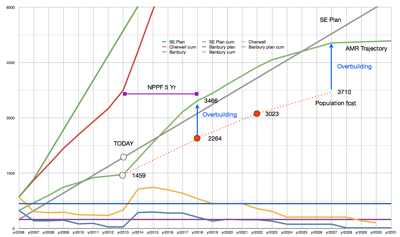Up until 2010 planning targets, for the number of new houses to get built, were handed out by central government under the Regional Spacial Strategies. For us this meant the number in what is called the SE Plan. The figure in this plan was to build 13400 houses in Cherwell from 2006 to 2026.
The changes to planning policy brought in by the coalition government meant four things
- the RSS was revoked, and the SE Plan 13400 target no longer valid
- a completely new National Planning Policy Framework (NPPF) was introduced
- under the NPPF councils had to replace the SE Plan number with a market based, factual forecast of housing need in the next 5 years, and a vision of needs in years 6-10 and 11-15. Updated annually and rolled forward.
- make a definitive Local Plan to describe the vision and strategy for their district
But what Cherwell did was lazy and to argue that the SE Plan was still valid, and they did not make any new market based forecast (they are not alone, neither have many other councils either…). They then extended it our to 2031 to a project a figure of 16750 houses to be built in a fixed 25 years.
They have never met the rate of building that the SE Plan defined, 670 houses per year. From 2006 to 2012 just 3744 houses were built, or 535 per year, against a "SE Plan" of 5360. The number built was however not restricted by the provision of land or planning approvals, with huge developments approved in Banbury and Bicester. It is however a realistic number which correctly reflects the growth in population plus the financial limitations of people to buy the houses.
Here are the numbers plotted out:

Ignore the lines at to bottom , they are the data from Banbury alone.
The top green line is the Cherwell SE Plan, under this the red line is the actual built up to 2013 and the trajectory (developer forecast) out to 2018 (5 year need). This neatly bring us back to the old Plan and Cherwell pat themselves on the back. But it is wrong.
The growth of need, based on population growth, not taking into account any financial limitations, is shown by the dotted red line. This is based on data from the ONS and DCLG and a study from Cambridge University (howmanyhomes.org) that gathered the data together - so it is national and reliable.
The net effect of this is that Cherwell is planning to overbuild houses that people won't or can't by. By 2018 developers have told Cherwell they are forecasting to build 2076 more houses than the population growth indicates.
To achieve this Cherwell Council have given new planning permission on huge swaths of green field land. Developers are very happy to have this, they gain asset value on land they have bought once planning permission is given and the land value rises. It is all a land grab, they have no intention of building...
The reality is that sufficient previously approved sites are simply not being built at Bankside in Banbury and the large Eco Town in Bicester because there is not the demand and the house prices are too high for people to afford a mortgage. The house prices are high because developers are greedy for profits (on top of the scurrilous growth in asset values they are getting) as the speculation cost they paid for the land in the housing boom times forced up prices. This was all well and good in the housing boom, but in the current climate the value of the land has fallen, the developers should take a hit on asset values, stop grabbing even more new land and sell houses at prices people can afford.
For completeness here is the data for Banbury:
